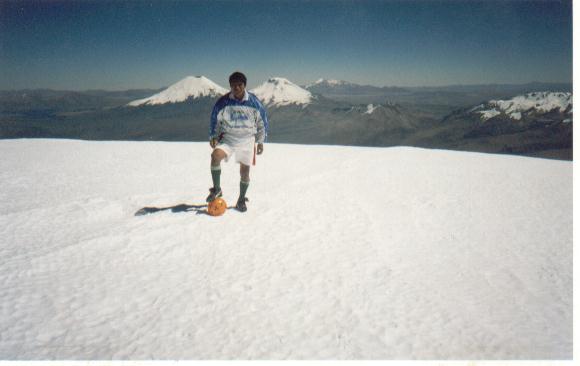
On the summit of Sajama 6542 m. In the background
the Parinakhota and Pomarape twin volcanoes.
Photos are copyrights of IPPA

On the summit of Sajama 6542 m. In the background
the Parinakhota and Pomarape twin volcanoes.
Photos are copyrights of IPPA
Following the frustrated attempt to carry out a soccer match on the summit of Sajama at 6542 meters above sea level on July 7th, 2001, a second attempt was left open, yet undefined.
One of the sources of failure was the fact that the first attempt was much publicized, and hence great expectation was aroused. Many groups decided to participate and as Anthropologist John Brett of the University of Colorado points out in a letter sent to us, "I just wanted to write and thank you for your invitation to participate in the Mt. Sajama climb and football match. I did indeed make it to the top along with my young Swedish climbing partner and 11-12 of the porters. Mario Miranda (the secretary of Club Andino Boliviano) made it to the top after the rest of us had headed down. I don't know what you heard about the process, but the weather was unquestionably grim with a wind chill factor that was at least 60 F and football (or anything else for that matter) was clearly out of the question. From my perspective as an outsider, there were some major organizational issues that will need to be addressed if this is attempted again e.g., no food at the high camp for the porters until 8:30 at night. Also that it is really too difficult a mountain to have dozens of inexperienced and/or out of shape climbers trying to make an ascent under time constraints. If the weather had been as bad on the ascent as it was on the top, I think people might have been killed. Much was learned so I think that if something like this is planned for the future, it might be better organized and have a higher chance of success." A local newspaper reported in similar fashion.
So the 3 Zubietas, Carlos Aguilar, and Mario Miranda gathered at IPPA and started making the plans for the second attempt with a different focus. The first consideration was that only the most experienced climbers should participate. And who else could it be than the local guides and porters?. Second, we would do it quietly, not having the information leak out to the press or anyone else, in order to avoid the presence of inexperienced people.
The weather was of course our first worry. Internet, newspaper and local weather reports, were searched every day. Satellite images constantly showed threatening curved bands of clouds extending from the south both on the Atlantic and the Pacific. We also had the time constraint that August is known as the "windy month". Locally it is advised "not to get married in August, because the winds will take away the marriage union bonds".
The enthusiastic group belonging to the La Paz Mountain and Trekking Guides Association, was told to prepare a group to go to Sajama on short notice. They readily agreed and for the fourth week of July 2001, they had between 11 and 13 people all set up with their equipment and climbing gear on stand-by. It was planned that the other team would be the Sajama local guides and porters, but complications aroused.
The Bolivian Vice-President Jorge Quiroga "Tuto" an enthusiastic mountaineer, who gave his strong and firm support to this venture, cancelled his participation the very last minute, because the Bolivian President had just been diagnosed as suffering from lung cancer with metastasis to liver at the Walter Reed, in the US. He had to let the mountain go for now, to prepare himself to run the Bolivian nation. But he will return to a similar venture sometime in the near future.
The participants of the first attempt, included members of Club Andino Boliviano, High Altitude Pathology Institute, Military Geographical Institution, SERNAP, Sajama porters and guides and Asociacion de Guas de montaa of La Paz guides, television crews belonging to CNN, SPN, Television Boliviana, Newspaper press reporters and photographers,. There were also some independent enthusiasts such as an American (John Brett), a Swedish and some other people from La Paz. Click here to read what the Swedish wrote about the first attempt.
This large group definitely overcrowded the high camp (that could only hold around 20 people). Also organizational issues arrived because each group made their own decisions. There was a general cook, that had difficulties feeding a large group, bad weather, etc, etc.
This is why the second attempt was so quietly prepared. Playing soccer on the plateau of Sajama at 6542 m., was not a joke. The first possible date projected was Friday July 27th. But this date was aborted because of storms.
In a meeting held at the Instituto de Patologia en la Altura, between the president of Club Andino Boliviano, Carlos Aguilar, the secretary Mario Miranda and the 3 Zubietas from IPPA, members themselves of the Club Andino Boliviano, the next probable date was fixed to Thursday August 2nd.
Two days before, on Tuesday morning, much to our surprise, we were informed that an International� group� was going to give it a try in one or two days, and that they would probably be heading to Sajama in a couple of days. We could not let down all the expectations Bolivian had in their countrymen.
Consequently, Gustavo Zubieta-Calleja (Jr.) and Luis Andres Zubieta with Leandro the sub-mayor and Teodoro the president of the civic group of Sajama (that had both come down unexpectedly that same day) immediately got on on the 3 and a half hour trip of paved road to the Sajama town, as an advance group. Gustavo Zubieta-Castillo (Sr.)� prepared his trip for the next day.
We previously contacted Agustin Gonzales e-mail, representative of the La Paz Association of Mountain Guides, and he told us that he could only bring four people, since the rest were guiding and porting other people around the beautiful mountains of Bolivia. He said however that some might return that afternoon, from the Huayna Potosi Mountain (6088 m), one hour drive from La Paz.
In the Sajama town (4300 m), Tuesday evening, on arrival at 9:30 p.m., things looked quite grim. The local guides and porters, were reluctant to participate because they had not been paid the services they rendered in the previous attempt. The President of Club Andino Boliviano and the rest of the participating members said they could not come because of illness, unable to leave work, obligations and other compromises.
Wednesday morning, Gustavo Zubieta-Castillo (Sr.) and Martiniano Vicente, his "camp" assistant, arrived at the same time that Agustin Gonzales made it to the town with a group of six. Enthusiasm began to grow in the people of the town, but not without several mishaps and difficulties. Coming and going, information rendering, possibilities calculations. Convincing and negotiations took most of our day. The previous mishap had left many doubts and feelings of insecurity. The morale was low.
The group was gathered in the local small hospital and final arrangements and instructions were given. For instance, how were we going to know that they had played the game?. We had no radios, so more primitive ways had to be sought. Gustavo Zubieta-Castillo (Sr.) came up with the idea of blasting some fireworks at half time.
At sunset, some threatening dark cumulus clouds began to gather on the south and south east. Very little wind was present. The operations base was IPPA�s light blue camper. We sat around the table to take minute by minute decisions. The comander officer was Gustavo Zubieta-Castillo (Sr.)� a retired coronel of the Bolivian Army.� He reminded us of the Dessert Fox, so we started calling him the "Sajama Fox".
Several problems knocked on our back door as we continued the planning. The soccer posts that had been taken to the top on July 7th, had been painted with wide black stripes. But television reports on the summit showed the porters carrying the 4 meter plastic tubes horizontally on top of their backpacks, something unrecognizable because of the white stripes. Hence we ordered that the white bands be painted red.
At 11:30 p.m., two guides came and told us that the 5 soccer balls that were previously prepared for the first attempt, would not be turned over by someone. We told them to go look for other balls and to tell the people who they got them from, that we would buy used balls. We waited and waited and sent two of us to help in the same mission. The first two finally showed up with an old ball, that gave us back some of our breath. Noteworthy, is the fact that Sajama is a poor town and hence a ball is an immense treasure there.
The guides of La Paz, prepared their banner by cutting white paper letters and gluing them on the back of a blue cloth. Then they all went to bed in their respective houses to catch a couple or less hours of sleep. The meeting time was set at midnight. At that hour, the star splashed clear sky gave way to a nearly full moon that projected its rays on the majestic Sajama, that on bouncing on the white snow cap gave a fluorescent impression that one gets when one sees a piece of white cloth in a dark room illuminated by "black light". The temperature was around �8 �C. Thirty minutes past midnight, only one of the players, showed up. One of us had to go find the houses of the players and knock on their doors to hear: "coming".. or "so soon?" or "Hummm", or "I didn�t sleep at all" or a self murmur barely understandable "I think I won�t go".
The name list of the players of both groups was handed to us. In the meantime, Gustavo Zubieta-Castillo (Sr.) and Jr. went looking for some more balls. At some doors, barking dogs froze our nerves. After coming and going we finally got 2 more balls. Our worries, as in the previous expeditions, was that some balls may be kicked too far and roll down the side of Sajama, to finally stop 2200 m meters below....
Some of the balls were painted with red spots, and we thought we were ready to go. But surprise, someone came up and said that the plastic elbows that had to connect the goal poles were missing. We made some suggestions but someone said he probably could find them at someone else�s house. Not nice to wake up someone in the freezing nights of a town of groups of adobe houses (or rather rooms), with wave shaped zinc roofs, metal doors and with scarce solar panel powered lights, and where silence is only broken by the wind, our hissing footsteps on the volcano ash sand and barking dogs.
Fortunately, they returned with the last fundamental thing. Or at least we thought so. Someone said "we need a shovel". In no time, it showed up. The engines of the two jeeps were running all through these preparations. One of them sounded irregular like it needed a tune-up. Oh Oh.
When the vehicles were finally packed, one with 8 hypoxia warriors and the other with seven, we gave them our farewell and last instructions: remain united at all times, be careful and the advice not to give up easily.
And off they headed into the cold night at 1:30 a.m. on August 2nd,
leaving a cloud of dust that gradually erased the red stop lights and left
us anxious for their well being and hopeful for their much awaited success.
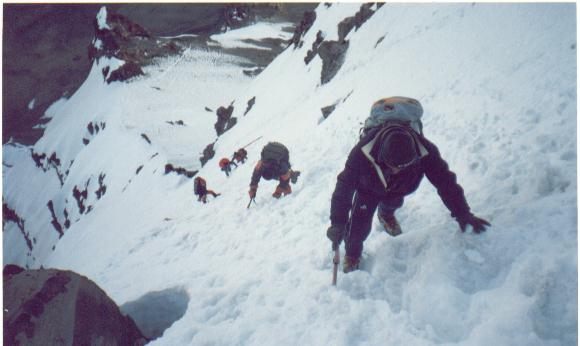
The ascent. Note that the last player is carrying
on top of his backpack, one of the poles that were used to put together
the goal posts.
Sleep for us in the small "hostels", with 5 hay mattresses beds in one room, cold air and a dim 12 VDC light was nearly impossible. When we were not talking or commenting, we were thinking, wondering, hoping, suffering.
Sunrise at around 6:30 appeared from the left side near the summit of Sajama. After washing up with scarce water, since water pipes were frozen and unoperational, we headed to the camper to wait for D day. It was of immense beauty, out there and not a cloud in the sky. The locals said that in the previous attempt the "TATA SAJAMA" (father Sajama), had been upset about something and had refused to let the expedition play soccer on its top. Now it seemed that he had given us his full agreement and rather was impatiently waiting.
The town was celebrating on the same day, the 62th anniversary of the foundation of the Park Sajama "SERNAP", National Services of Protected Areas. A bicycle race down the ash sandy road for both men and women started the day. Then there was a celebration on the central plaza, with authorities from Sajama, SERNAP, international cooperation agencies, mayors, local authorities and general public.
With the aid of a pair of binoculars we tried to spot the climbing group, but there is only a small window of opportunity to see them from the town, as they leave the area of the high camp. The initial plan was for them to arrive to the summit at around 10:00 a.m., but since there was a delay in departure time of 1 hour and a half, we calculated they would probably reach the summit at around 11:30 a.m. Yet, much to our surprise at 15 minutes to 10:00 a.m., one of the locals that lived to the left of Sajama said that he had seen the group reaching the summit. We concentrated on trying to listen to the blast of fireworks, but due to the distance it was more than evident that it would not be possible.
About half an hour later, and with tremendous excitement, we saw the
firework�s tiny smoke spots as they blasted high above the Sajama
summit. They had played the first half time of a historic game! And these
young formidable men, that had followed the instructions precisely, would
show the world their incredible capacity for exercise at extreme altitudes.
We called La Paz, through the only phone in town to announce the extraordinary
accomplishment. We later learned that 20 minutes per side were played and
that the score was tied at three to three.
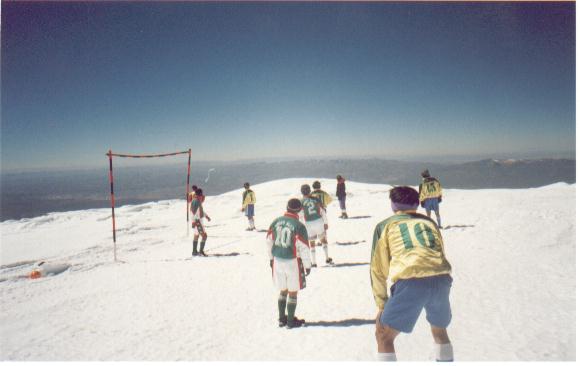
The actual game. Observe the color of the sky and how it becomes whiter
as it touches the earth.
Photos are copyrights of IPPA
The rest is history. But if we don�t write about it now, the details will be forever forgotten.
The International team, arrived in a bus at around 2:00 p.m. completely
unaware of what had happened. Gustavo Zubieta-Castillo (Sr.) approached
them and said "welcome to Sajama, we hope you enjoy this wonderful place".
To which they cordially replied "thank you" and went off to head to the
base camp.
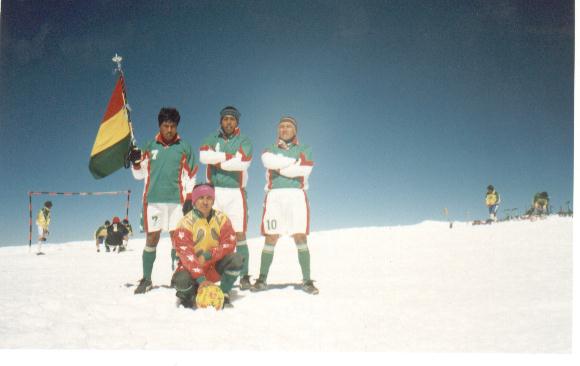
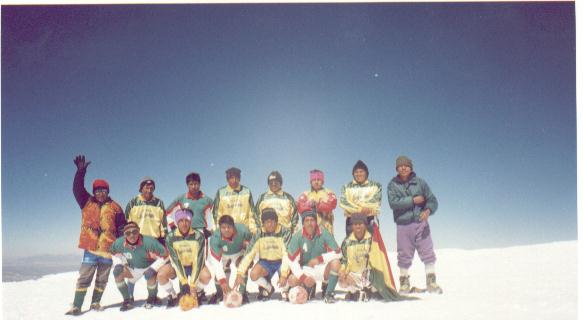
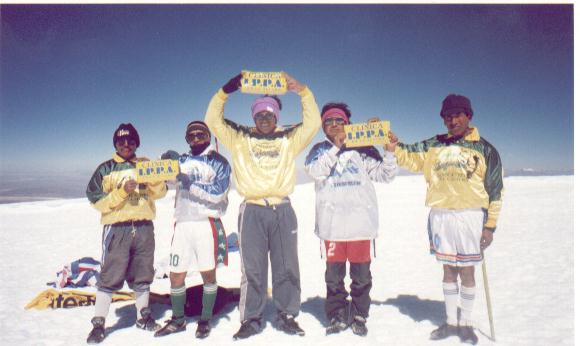
The players spontaneously took this photo.
�
Now the hours of expectation became looonnnnnggg. We feared that someone could have an accident coming��� down, from being tired, and particularly because they wanted to rush back and communicate their success to all of us, anxious spectators. The Sajama has beautiful Geysers and the two twin volcanos, Parinakhota (6132 m)�� and Pomarape (6222 m), that are beautiful to watch. The thermal springs that have not changed in generations and retain their primitive charm, was this time not much of an attraction for us.
They had told us that they would probably return by 3 p.m. But some of the local people had diverse opinions. Some said "it won�t be long" and others, "no way, it takes 2 days to come down". The sun was piercing hot and the expectation immense.
At around 6:00 p.m. we could see the dust tailed spots of two vehicles approaching. We quietly waited for a few minutes and someone yelled: ITS THEM!!
The front jeep had the headlights on and a red, yellow and green flag was proudly waiving. The horns beeped and all the townspeople came out to the streets to receive their heroes that had just traversed the frontiers of history.
A band, composed of typical wind and percussion instruments: ke�ua, zampo�as, bombos, and a platillo, filled our ears with melodies and our eyes with tears. We hugged those boys firmly, with all our pounding hearts and congratulated them. We then took photos of the two teams and along with them jogged around the ash sand plaza triumphantly. Both teams received their two champion cups, which the Olympic Federation had donated. We packed our bags and headed home, tired but with the satisfaction characteristic of "mission impossible accomplished".
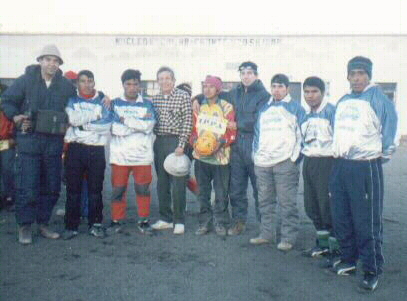
The 3 Zubietas with the team from the La Paz Trekking
and Guide Association after descent
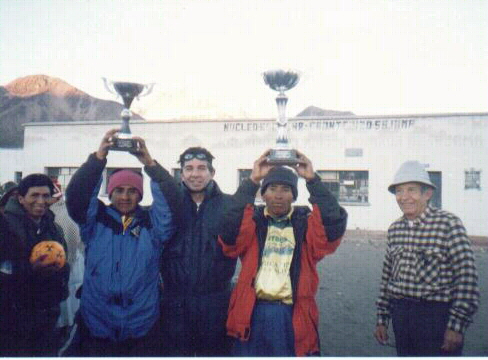
The two team captains Agustin Gonzales and Abdon Alvarez,
Dr. Luis Andres Zubieta in the center and Prof. Dr. Gustavo Zubieta-Castillo
(Sr.) at right.
Participating players:
The Club Sajamaï
La Paz Mountain and Trekking Guides Association
Abdon Alvarez Perez (Captain) Agustin Gonzales Mamani (Captain)
Reynaldo Calle Contrerasï Lorenzo Ramiro Lima
David Mollo Laura Juan Alaia Llusco
Aurelio Mollo Jimenez Rolando Huanca Mamani
Mario Perez Mamani Agustin Alaia
Cosme Calle Lovera Israel Yujra (didn't summit)
Primo Quispe Luna
Martin Mamani Cari
Juan Caballero Churata
Marcelo Pairo Contreras
Mario Calle Lovera
In honor of the truth, this is what happened.
Gustavo R. Zubieta-Calleja (Jr.)
High Altitude Pathology Institute (IPPA clinic)
La Paz, August 4th, 2001